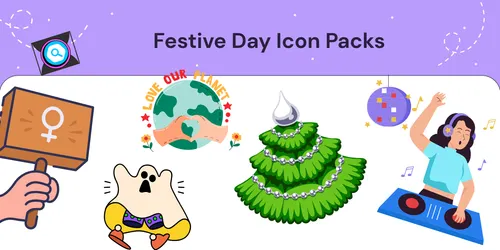
What Is Vector Art and Where to Use It?
Should you create your designs in vector format? Let’s find out.
Images serve as a powerful tool for brands to narrate their stories boldly.
Indeed, our brains are wired to process visuals remarkably faster than text – up to 60,000 times quicker, to be exact. Furthermore, a staggering 90% of the information that gets transmitted to our brains is conveyed through visual means. Leveraging this can help you get your point across more efficiently.
In this article, we will be looking at vector art, one of the most commonly used file types for digital art and learn what it is, compare it with other formats, and see learn how vector graphics can add personality to your business and visual communication.
What is vector art?
Vector art is a form of digital art that is created using vector design software. This type of design doesn't rely on traditional pixels to form an image. Instead, it essentially composes of points, lines, curves, and shapes that are all based on mathematical expressions. This unique method of creation is what sets vector art apart from other digital art forms.

The beauty of vector art lies in its high resolution and scalability. Whether you want to size it down or scale it up, a vector image never loses its quality. Vector graphics are an adaptable asset in your creative toolkit due to their flexibility and functionality. You have the freedom to adjust the size and color of the images and even remove any unwanted shapes or lines, making vector art highly customizable to fit your needs or requirements.
Raster vs Vector Graphics
One of the most popular design or graphic formats is raster-based and vector-based graphics. In contrast to vectors that consist of points, lines, and curves, raster images are made of a grid of colored pixels. If you zoom in, you'll notice these tiny squares.
The key difference lies in resolution dependence. If you scale up a raster image, it tends to lose quality due to its dependency on the fixed number of pixels it was created with. But vector images can be resized infinitely without any compromise in quality. Additionally, vector files do not require as much storage space as raster files.

When it comes to file formats, raster graphics are commonly available in JPEG, PNG, GIF, TIFF, BMP, and PSD formats, while vector graphics are typically found in SVG, AI, EPS, DAE, PS, and EMF formats. Regardless of your project's needs, IconScout's large library of design assets can be downloaded in some of these popular file formats.
When and where to use a vector?
While raster graphics have their benefits, particularly in digital photography with their ability to capture color depth and details, vector graphics offers unique advantages. They provide high-quality, scalable images without bloating file sizes and are a preferred choice for a variety of design projects due to their versatility.
Consider the use of vector graphics in business, for instance. They're found in a broad range of applications, be it the creation of signs, posters, company logos, illustrations, billboards, or even video production. They're particularly valuable when a project calls for careful organizing and arrangement of text, graphics, and other structural elements.
Likewise, they're also useful in UX/UI design for various digital platforms like websites and apps. This is because vector illustrations can deliver crisp visuals that meet your specific needs, all without the hassle of resizing issues.
Want to create your own vector design?
With this newfound knowledge of vector art, you're probably brimming to explore this diverse and fascinating form of digital art. Creating your vector designs can be done using various illustration and graphic softwares, and they can be conveniently exported in different vector formats.
If you don't feel confident creating your vector designs yet, you have the option even to browse and find high-quality design assets within IconScout library. This library offers thousands of options when it comes to illustrations, icons, 3D illustrations, Lottie animations. You can easily incorporate these design assets into your designs, spanning across your preferred design and developer platforms.
If you are looking for additional depth in your designs, an SVG to Lottie converter can breathe life into your static designs. This can transform your work into engaging, animated pieces. Check out this blog article to understand the 'what' and 'why' reasoning behind changing your SVG to a Lottie.
Till next time, happy designing.



















